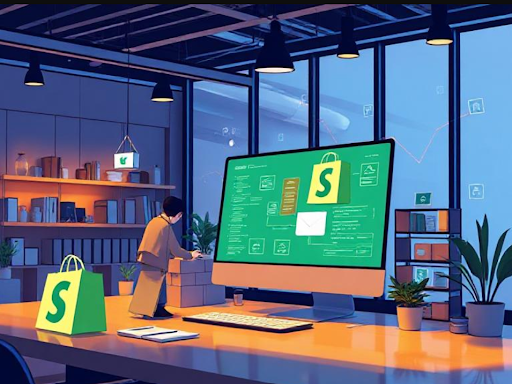Shopify’s a leading e-commerce force. Thing is, tech’s moving fast, and customers? They’re changing too. So, stuff like AI, fancy website setups, even paying with crypto—it’s all coming. Businesses need to figure this out, or they’ll get left behind. Getting a solid Shopify website development company on your side is a smart move. We’re breaking down what you need to know for 2025.
-
AI is Taking Over Personalization & Automation
AI isn’t something out of a sci-fi movie anymore—it’s already changing how online businesses run. Shopify has been rolling out AI-driven tools that make life easier for store owners, helping them improve customer experience, manage stock, and automate everyday tasks. And in 2025, things are only going to get more advanced.
What’s Changing in 2025?
- Better product suggestions based on real-time shopping habits.
- Smarter chatbots handling orders and returns.
- Predictive inventory to prevent stockouts.
How Developers Can Stay Ahead:
- Build AI-integrated tools.
- Learn AI-powered APIs.
AI is only going to grow from here, and businesses that use it effectively will have a serious advantage.
-
The Rise of Headless Commerce
E-commerce is evolving fast and so businesses are looking for more flexibility while designing their online stores. And that’s where headless commerce comes in. Instead of sticking to a rigid platform setup, brands can separate the front-end from the back-end, giving them full creative control. Shopify is making this transition easier with its Hydrogen and Oxygen frameworks, and by 2025, more businesses will be making the switch.
Why More Brands Are Going Headless:
- Faster websites, better SEO.
- Full customization.
- Integration with other tools.
What Headless Commerce Means for Shopify Developers:
- Learn Next.js, React.js, Vue.js.
- Master Shopify’s Storefront API.
As e-commerce keeps growing, headless commerce is becoming the go-to approach for brands that want to stand out in a crowded e-commerce space. Also, businesses that embrace headless commerce will have the edge. It’s all about delivering a faster, smoother and more personalized shopping experience for the customers.
-
The Rise of AR and 3D Shopping
Customers want interactive and immersive experiences rather than just scrolling through product images. But what makes this possible? The answer is Augmented Reality and to the benefit, Shopify already supports this as well as 3D models. In the future even more businesses will be using these integrated features to enhance customers’ experiences.
How AR is Enhancing Online Shopping
- Visualize products in real life.
- Detailed 3D product views.
- Fewer returns.
What Developers Should Prepare For
- Create AR-friendly store designs.
- Learn WebXR APIs and 3D modeling.
Businesses that adopt these technologies will offer customers a more immersive shopping experience, setting themselves apart in a competitive market.
-
Voice Shopping is Changing Online Retail
More people are using and shifting from typing out their searches to voice assistants like Alexa, Google Assistant and Siri for online shopping. Customers can simply speak a command instead of typing while searching for products, place orders or reorder past purchases using these voice assistants. By 2025, Shopify stores will be more optimized for voice interactions, making shopping even more convenient for their customers.
Why Voice Shopping is Gaining Popularity?
- Faster than typing.
- Easy reorders.
- Natural search terms.
What Shopify Developers Should Focus On
- Make stores voice-compatible.
- Explore NLP (Natural Language Processing) tools.
As technology evolves, businesses that integrate voice shopping will stay ahead by offering customers a seamless and effortless way to shop.
-
Sustainable and Green Commerce
Consumers are becoming more conscious about the environment and so Shopify is taking the lead in sustainable e-commerce. Shopify’s Planet App already helps merchants offset carbon emissions and in 2025, new features will make sustainability even easier to track.
Sustainability Trends in Shopify:
- Carbon-neutral shipping.
- Green-certified stores.
- Environmental impact analytics.
For Shopify Developers:
- Develop eco-friendly themes.
- Integrate sustainability tracking APIs.
6. Blockchain & Crypto Payments Will Be Common
As cryptocurrency adoption is growing in the e-commerce sector, Shopify is keeping up with the trend and embracing crypto payments for faster and more secure transactions. It is expected that by 2025, more Shopify stores will be ready to accept Bitcoin, Ethereum and other digital assets as a payment method for all the transactions.
Why Crypto Matters for E-commerce:
- Lower fees.
- Secure transactions.
- Global reach.
How Shopify Developers Can Prepare:
- Learn Shopify’s Blockchain API.
- Build NFT loyalty programs.
What’s Next for Shopify? Staying Ahead in a Changing Market
E-commerce? It’s a constant shift. Adapt AI, voice tech, AR—these aren’t just buzzwords for their advantages. Adapting isn’t optional but it’s about giving your customers a better experience. For store owners aiming to grow, experienced developers are key.
Think about it—how happy your customers would be with a really good Shopify store. It’s a game-changer for engagement and if you’re considering any upgrades, now’s your chance! Partner up with a reliable Shopify website development company, and you’ll be set for whatever comes next. Don’t delay—the market won’t wait.


